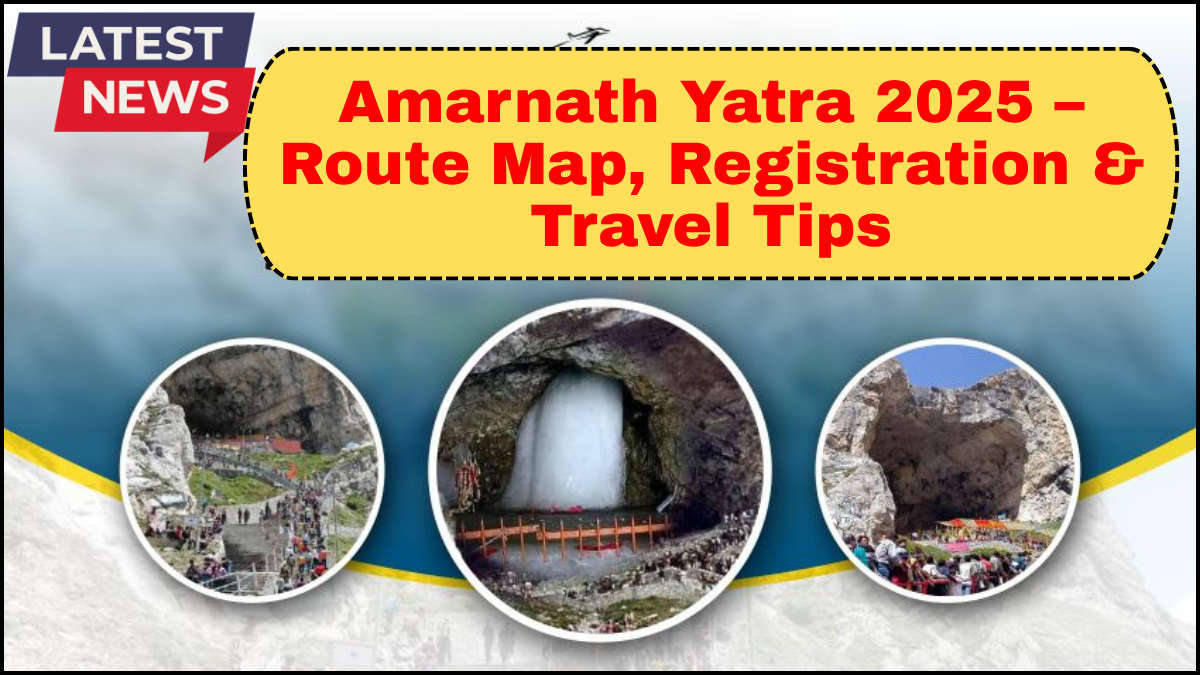The Amarnath Yatra is more than a spiritual journey; it’s a test of faith, endurance, and devotion. Held annually in the Himalayan state of Jammu and Kashmir, this pilgrimage draws hundreds of thousands of devotees to the sacred Amarnath Cave, home to the naturally formed ice Shivlinga.
As Amarnath Yatra 2025 approaches, it’s crucial to prepare thoroughly. Here is everything you need to know about the Amarnath Yatra Route Map 2025, registration process, expected weather conditions, and smart travel tips to ensure a safe and rewarding experience.

Amarnath Yatra Route Map 2025
There are two main routes to reach the Amarnath Cave:
1. Pahalgam Route (Traditional Route)
- Starting Point: Pahalgam (96 km from Srinagar)
- Total Trekking Distance: Around 46 km
- Route: Pahalgam → Chandanwari → Pissu Top → Sheshnag → Mahagunas Pass → Panchtarni → Amarnath Cave
- Best For: Pilgrims looking for a gradual ascent and scenic trail.
This route is longer but considered more comfortable due to its even elevation gain. Ponies and palkis are available along the way.
2. Baltal Route (Shorter but Steeper)
- Starting Point: Baltal (15 km from Sonamarg)
- Total Trekking Distance: Around 14 km
- Route: Baltal → Domail → Barari Marg → Sangam → Amarnath Cave
- Best For: Physically fit and experienced trekkers.
This route is steep, more challenging, and best suited for those who prefer a quicker journey. Helicopter services are available from Baltal to Panchtarni.
Registration for Amarnath Yatra 2025
Mandatory Registration is required for all yatris. Without valid registration, access to the yatra track is not permitted.
How to Register:
- Online Portal: Visit the official Amarnath Shrine Board website (www.shriamarnathjishrine.com)
- Offline Mode: Authorized bank branches such as Punjab National Bank, Yes Bank, and Jammu & Kashmir Bank
- Required Documents:
- Compulsory Health Certificate (CHC)
- Government-issued photo ID
The registration generally opens in April. Early booking is advisable as slots fill quickly due to the yatra’s limited window (usually 45-60 days during June to August).
Amarnath Yatra 2025 Weather & Climate Overview
Weather plays a crucial role in the success and safety of your pilgrimage. The Amarnath Yatra is conducted during summer, but high-altitude regions still pose unpredictable weather challenges.
- Temperature Range: 5°C to 20°C during the day; it can drop to sub-zero at night
- Rainfall: Sudden showers are common, especially in July
- Snowfall: Snow may be present at higher altitudes even in summer
Travel Tip:
Always carry waterproof clothing, thermal layers, sturdy trekking shoes, and a windcheater. Weather updates are regularly issued by the Shrine Board—monitor them closely.
Travel Tips for a Safe Yatra
1. Physical Fitness: Start prepping at least a month before with cardio, yoga, or daily walks. High-altitude trekking requires endurance.
2. Altitude Sickness: Be alert to symptoms like dizziness, fatigue, or breathlessness. Acclimatize properly before ascending.
3. Packing Checklist:
- Warm clothes
- Raincoat or poncho
- Torch with extra batteries
- First aid kit
- Dry fruits and energy bars
- Water purification tablets
4. Local Connectivity: Mobile connectivity is limited. Only postpaid SIMs from select providers (BSNL, Jio) work beyond certain points.
5. Emergency Helpline: Keep emergency contact numbers saved and always inform someone of your route.
FAQs
Q1. What is the duration of the Amarnath Yatra 2025?
The yatra usually spans 45 to 60 days, starting in late June and concluding in August. Exact dates will be announced by the Shri Amarnathji Shrine Board.
Q2. Can senior citizens participate?
Yes, but those above 75 years or with medical conditions are generally advised to consult their doctor and may face restrictions based on health certificate assessments.
Q3. Are helicopter services available?
Yes, from both Baltal and Pahalgam to Panchtarni. Advance booking is highly recommended.
Q4. Is solo travel advisable?
Group travel is safer. If traveling alone, stay close to registered camps or groups.
Q5. What should I do in case of a medical emergency?
Medical camps and rescue teams are stationed along the route. Report to the nearest camp or alert a security officer immediately.
click here to learn more